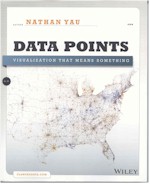 |
|
|
| ||||||
|
|
This page is the original source of this review, though you may also find it on Amazon or other sites. | ||
| Book Reviews Home | Free Audio Books | |
 |
Book Review of: Data PointsVisualization That Means Something Price: $24.22 Availability: Usually ships within 24 hours |
| Review of
Data Points, by Author (Softcover, 2013) (You can print this review in landscape mode, if you want a hardcopy) Reviewer: Mark Lamendola, author of over 6,000 articles. Having suffered through agonizing PowerPoint "presentations" that make me yearn for being waterboarded just so I can get out of there, I'm very familiar with being subjected to data visualizations that confuse and annoy. I've also seen this in books, magazines, and online articles. Many years ago, I worked as a magazine editor. I wrote and edited many articles. In the course of this, I submitted illustration ideas. Some were pretty good. But some were, to be kind about it, inept. I just didn't have that graphical eye to make the intended point. The magazine's graphic artist, who is still there, would ask me a few questions and come back with something that totally nailed the idea I was trying to convey. Sometimes, he would just strip away semi-relevant detail. Other times, he'd add a flourish that made sense of it all. And other times, he'd come up with something quite different from what I submitted. One time when I told him how much I appreciated his "magic," he said, "There's no magic. Think of your graphics the way you edit your articles." What insight! I told the story efficiently and clearly in text, but didn't carry that thought process over to the graphics. This concept is one of the major themes that Mr. Yau is relating in this book. And it's one that is typically not understood. While Yau's intended target reader is the quant who needs to communicate ideas from the data, everyone else can benefit as well. In this modern age of spin, lying, and misrepresentation, especially from those frauds occupying positions of power in the District of Corruption, it helps to understand the difference between an accurate visualization and one that is produced with intent to deceive. My personal estimate, for what it's worth, is 9 out of 10 people are regularly deceived by dishonest visualization techniques. Odds are, you're in that group. Read this book, and you won't be. His tour of various charting types is extensive, and his explanations are insightful. Most people who create charts think in terms of bar charts and pie graphs, with little or nothing else in their repertoire. But the available chart types go far beyond that. Understanding what your options are can be quite liberating for you. Selecting the right option can make the difference between a yawn or a wow on the part of your audience. My company sells data graphics tools for Crystal Reports. Hop over to the crystalkeen Website, even if you don't use this software, and look at the various chart types. That'll be an eye-opener, and it will also help you see another way a book like this adds hugely to the literature. This book is lightly technical in nature. Non-quants might not understand some of the references. Statisticians, professional report designers, professional presenters, and others who present "from the data" via visualizations might find this book too basic for their tastes. But I caution such people: I have seen your work, and you are found wanting! Well, most of you anyhow. Your takeaway will be "simplify, simplify, simplify." That, and probably some related tips such as don't add marginally relevant information and don't mislead by "zooming in" on scales. I think too often people get lost in the wiz-bang, see what I can do with the software mentality and forget the reason they are producing the report or presentation aid in the first place. My impression of this book is its primary purpose is to help the reader correct that deficiency and consequently be able to convey the intended message with clarity, accuracy, and precision. Yau understands this about graphics. He needs to apply it to his writing, however. My advice to him would be, "There's no magic. Think of your text the way you edit your graphics." He does the reader a disservice with his many grammar gaffes and syntax errors. His word choices are sometimes inappropriate to the text. An example is his frequent misuse of "a lot." This phrase originally referred to the space that physical objects occupied. They took up an entire lot, so you had a lot of them. It would be better, when discussing the non-material, to say "many" or something similar. I also don't like it when people use a Latin plural noun as a singular noun in a sentence. Data is the plural of datum. I'm willing to overlook this here, partly because Yau knows the material extremely well and partly because a common (mis)usage of "data" is to denote a body of data. It's increasingly becoming shorthand for "group of data." Despite the writing weaknesses, Yau left me feeling that my time reading this book was well-spent. Sometimes, a good subject matter expert can stumble with the language but still help the reader or listener raise his or her game. I feel Yau achieved what he set out to do, and I am the better for it. This book consists of 7 chapters occupying 290 pages. It's graciously endowed with ample color photographs and color illustrations. | |
| |||||